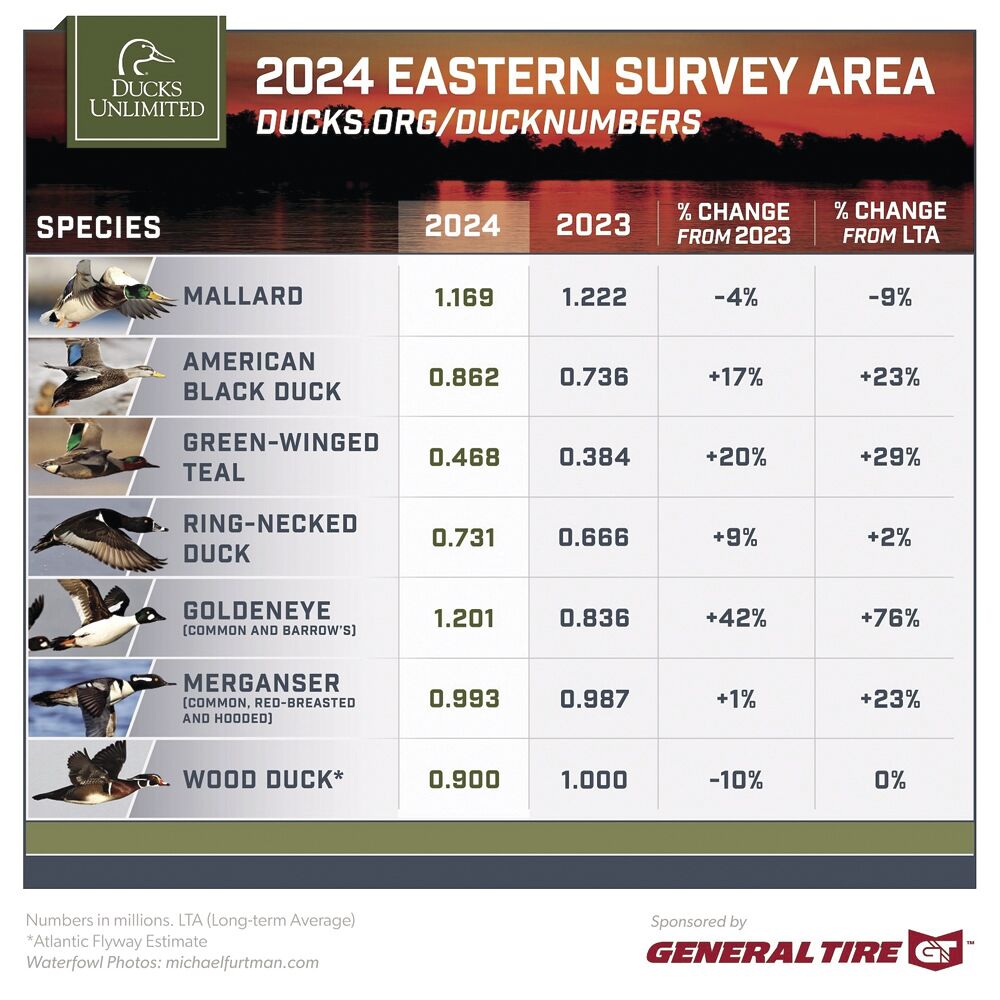OVERTIME OUTDOORS: U.S.F&WS report is a ‘massive win’ for conservation; more ducks in ‘24
Published 12:00 am Wednesday, August 28, 2024

- eastern ducks
The long-awaited, highly anticipated U.S. Fish and Wildlife Service’s 2024 Waterfowl Population Status Report was released Aug. 20 and it should put more smiles than frowns on the face of duck hunters from the Teche Area to California to Michigan to Maine.
The report notes the estimate for total breeding ducks in the traditional survey area was 34 million, a 5 percent increase over the 2023 estimate of 32.3 million and just 4 percent below the long-term average (since 1955).
It’s being called a “massive conservation win” because the results show the first increase in the total number of breeding ducks surveyed since 2015. As a result, U.S.F&WS will recommend continued liberal duck season framework for 2025-26.
Ducks Unlimited’s chief scientist, Dr. Steve Adair, said, “This year’s report suggests that some duck populations had better production last year than expected, with good carryover to spring of this year.
“While estimates were down in the prairies, population levels were up in northern breeding regions. We heard reports of an early spring, with ducks migrating through when the prairies were still dry and likely overflying to the Boreal Forest. This is a pattern we’ve seen many times before, and it appears to have been the case again this year.”
However, (isn’t there always a however?), there’s a sobering side to the otherwise encouraging report: Overall duck population numbers remain 4 percent below the long-term average. That’s due to the lasting effects of many years of drought in the Prairie Pothole Region.
The Prairie Pothole Region, historically referred to as the “Duck Factory,” supports more than half of the continent’s breeding ducks.
“The health of the Prairie Pothole Region is directly reflected in this annual report,” Ryan Callaghan, MeatEater’s director of conservation, said in a story Aug. 20 on the MeatEater website. “Keeping this region productive is tied directly to massive conservation policies like the Clean Water Act and the North American Wetlands Conservation Act. These acts are spearheaded by countless conservationists at the federal, state and nonprofit levels, who recognize and continue to fight degradation to this region such as habitat loss, drain tiling and development.”
What can duck hunters do to help habitat for healthy waterfowl numbers in the future?
“Be sure to buy your duck stamps and understand where your ducks come from,” Callaghan said.
The U.S.F&WS’ first survey was in 1947. Its primary goal is to provide annual input on spring population size and direction for 19 duck species, Canada geese and swans and to evaluate prairie breeding habitat by estimating the count of May ponds.
U.S.F&WS and the Canadian Wildlife Service collect the data by sending air and ground crews out every spring (except the coronavirus year of 2020) across a 2-million acre survey area from Alaska’s Seward Peninsula to the shores of Newfoundland and south nearly to the Nebraska-South Dakota border. CWS also surveys portions of eastern Canada with three helicopter crews.
This year’s survey is a shot in the arm, especially for the beaucoup waterfowlers locally, statewide and nationwide who unselfishly donate to nonprofit conservation organizations such as DU and Delta Waterfowl.
We’ll have to wait till next season but a three-pintail daily bag limit will be recommended for all flyways for 2025-26. After all these years we may have the opportunity to bring home three pintails next season for the first time since 1997.
The estimated pintail population is down 11 percent from 2023 (1.975 million compared to 2.219 million) but at a level that will provide the three-pintail limit in the future.
Duck hunters who never want to miss even one special teal season each September are being put on alert. Changes are coming to the early teal season in 2025 with U.S.F&WS recommending a nine-day season with a six-bird daily bag limit for the Mississippi, Central and Atlantic flyways, according to the report.
Why? Blue-winged teal numbers in the traditional survey area dropped 12 percent this year from 2023 to an estimated 4.6 million. U.S.F&WS guidelines set in 2014 grant a 16-day season in those three flyways when the population estimate is above 4.7 million, a nine-day season when the estimate is between 3.3 and 4.7 million and a closed season below 3.3 million.
It’s interesting to note that “production states” in the three flyways that choose not to have an early teal season will be offered two “bonus teal” during the first nine days of the 2025-26 regular season.
Thankfully, the federal agency’s recommendation doesn’t alter season length and bag limits for 2024.
DON SHOOPMAN is outdoors editor of The Daily Iberian.





